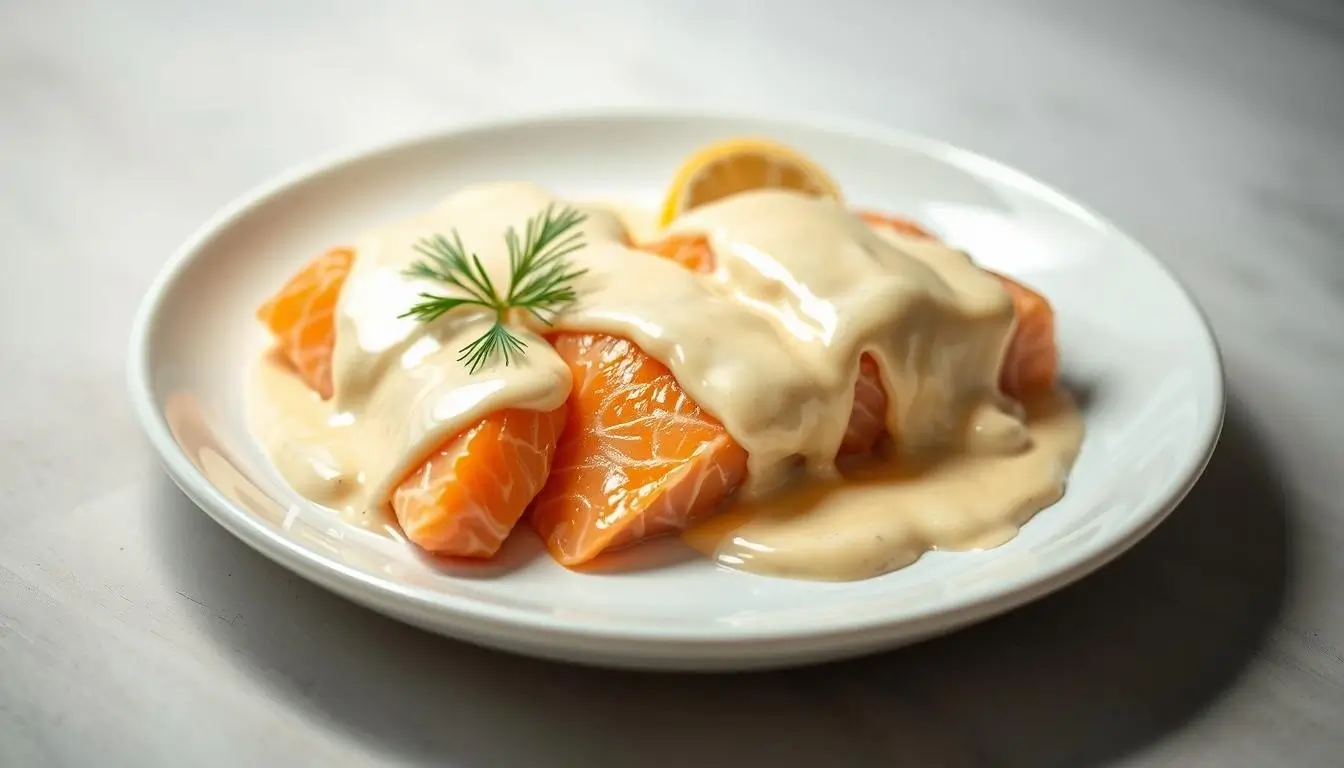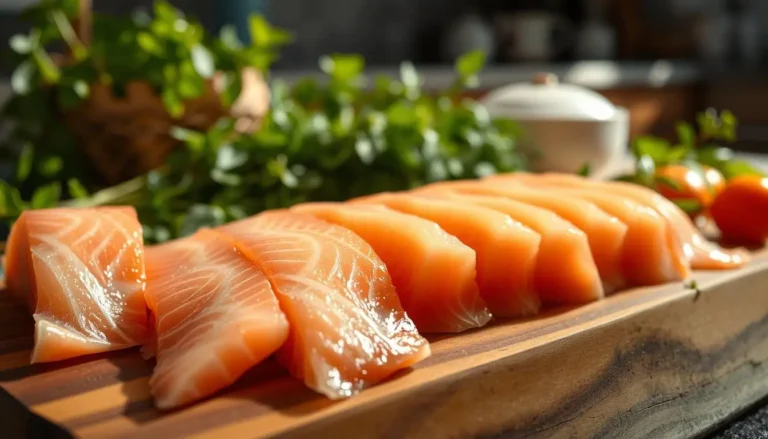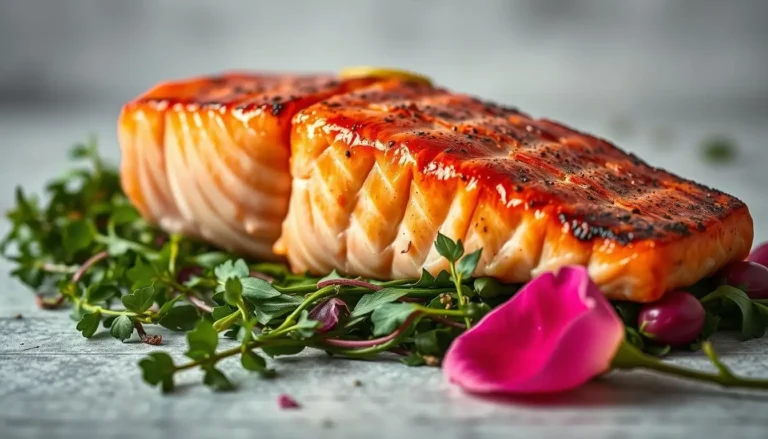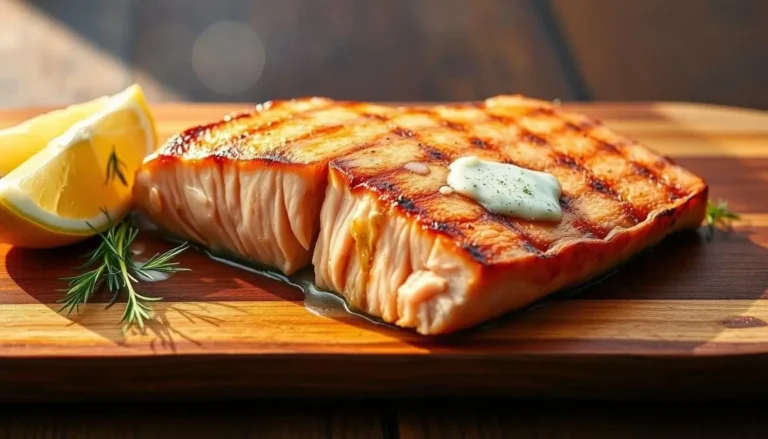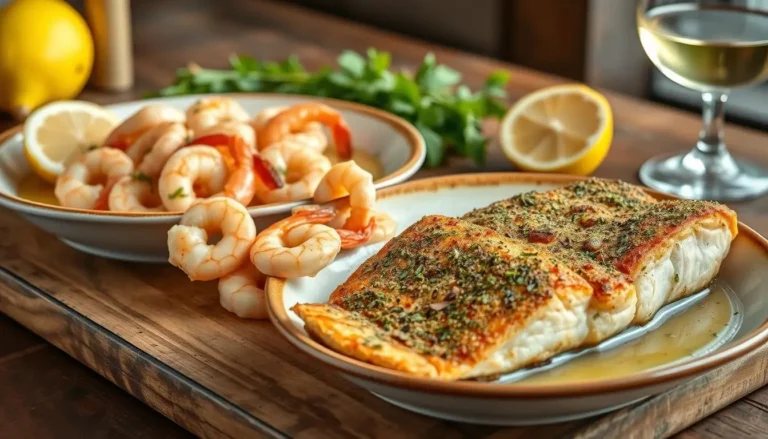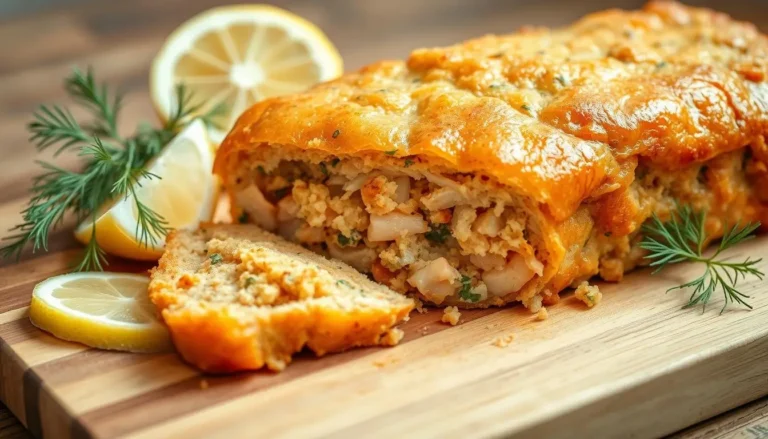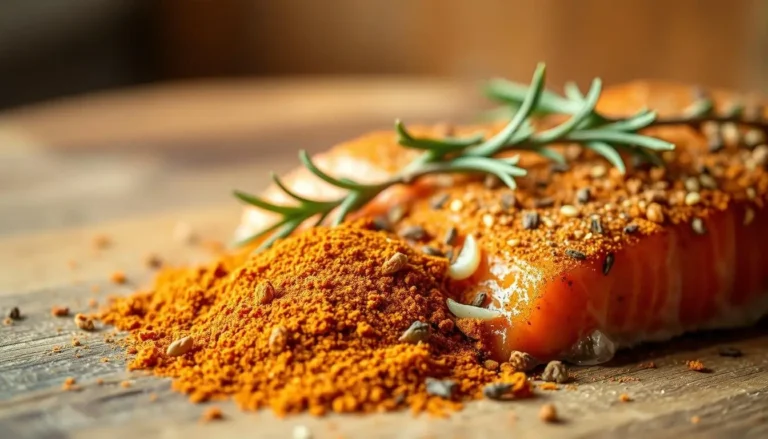Salmon Mayonnaise: A Simple Way to Enhance Your Dish
Table of Contents
Salmon Mayonnaise
What if a single ingredient could turn ordinary meals into restaurant-quality dishes? Imagine a creamy, savory addition that elevates everything from sandwiches to salads in seconds. This isn’t magic—it’s the power of a flavor enhancer hiding in plain sight.
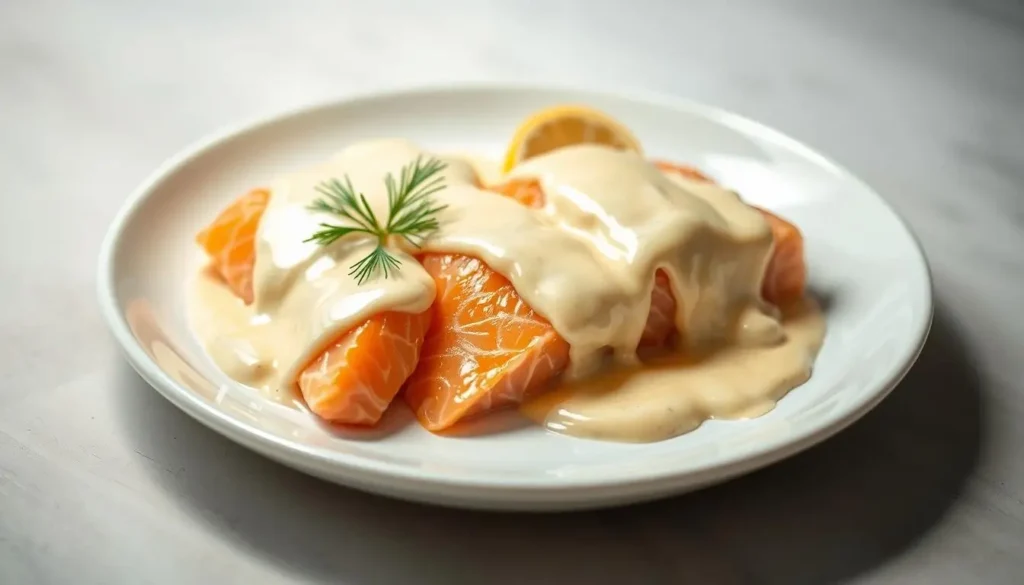
Combining tender, flaky fish with a rich condiment creates a dynamic duo that transforms basic recipes. The secret lies in balancing simplicity with bold taste. You don’t need hours in the kitchen or rare ingredients—just a focus on quality and smart pairing.
We’ll show you how to craft this versatile topping in minutes. Whether you’re layering it on toast or mixing it into pasta, the result is always satisfying. Fresh, high-protein seafood and a smooth base work together to add depth to meals without overwhelming your palate.
Key Takeaways
- This creamy blend instantly upgrades everyday dishes with minimal prep time.
- Fresh, high-quality seafood ensures a clean, vibrant flavor profile.
- Perfect for busy cooks who want gourmet results without complexity.
- Pairs well with salads, sandwiches, or as a dip for vegetables.
- Customizable with herbs, spices, or citrus for personalized twists.
Introduction to the Delicious World of Salmon Mayonnaise
Ever wondered how a single spread could transform your weeknight dinners into gourmet experiences? This creamy creation combines tender fish with a velvety condiment, creating layers of richness that surprise even seasoned food lovers. A friend’s clever kitchen trick sparked this trend—using mayo to lock in moisture while baking—and it’s now a modern staple.
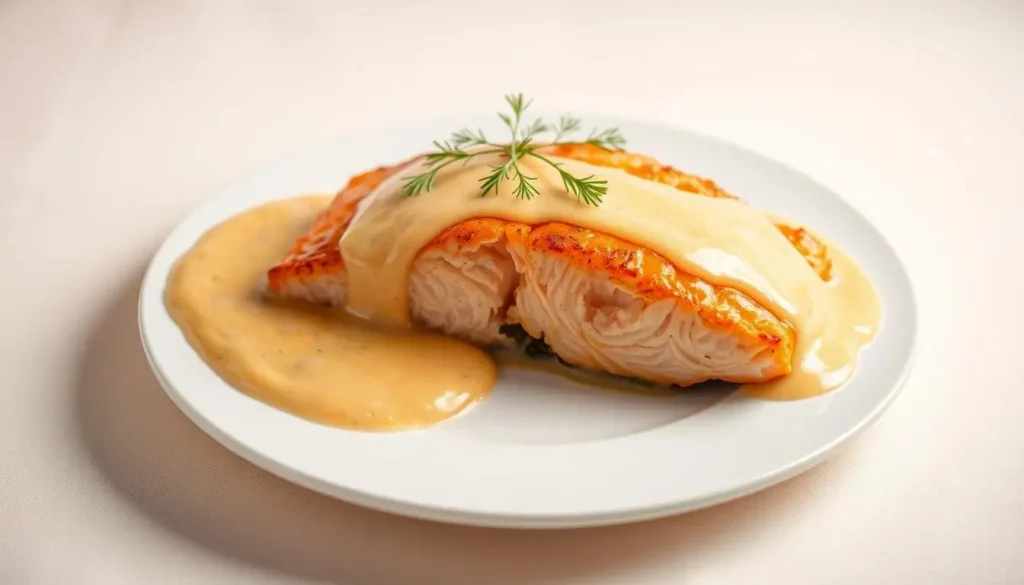
Discover the Flavor and Simplicity
The magic lies in balancing savory, buttery notes with a subtle tang. Fresh herbs or lemon zest can elevate the flavor further, making each bite vibrant. Unlike traditional recipes that dry out seafood, this method ensures juicy results every time.
Why You’ll Love This Recipe
Five minutes of prep separates you from a dish that impresses guests or upgrades solo meals. Quality matters: opt for wild-caught fish and full-fat condiments for optimal texture. The oven does the heavy lifting, caramelizing the topping into a golden crust while keeping the center tender.
Ready to explore how basic ingredients become extraordinary? The next sections break down sourcing tips, mixing techniques, and baking secrets to master this crowd-pleaser.
Origins and Inspiration Behind This Recipe
How did a simple kitchen experiment become a culinary sensation? It began when a home cook discovered a clever way to lock in moisture while baking fish. Their secret? A quick spread of mayo mixed with basic seasonings.
The Story Behind the Salmon Mayo Trend
The original method used just salt, pepper, and a thin layer of mayo to protect delicate fillets. Lemon slices added brightness, while butter created richness. But over time, cooks swapped butter for grated parmesan—a twist that added savory depth without extra grease.
Timing proved crucial. Baking for 15-20 minutes at high heat formed a golden crust while keeping the center tender. Friends who tried the dish demanded the recipe, sparking a wave of adaptations. Some added garlic, others dill—each tweak reflecting personal taste.
This evolution shows how humble ingredients can inspire creativity. What started as a practical solution became a beloved technique, proving that great flavors often come from unexpected experiments.
Essential Ingredients for a Perfect Salmon Mayonnaise Dish
The secret to an unforgettable dish lies in the quality of its core elements. Fresh, vibrant components work together to create balanced flavors and textures. Let’s break down what you’ll need to craft this standout meal.
Choosing the Best Quality Fish
Look for fillets with a glossy sheen and firm texture. Avoid any strong odors—freshness should smell clean, like the ocean. Wild-caught options often deliver richer flavor and higher protein content compared to farmed varieties.
| Ingredient | Role | Pro Tip |
|---|---|---|
| High-Quality Fish | Provides lean protein and omega-3s | Press flesh gently—it should spring back |
| Avocado Oil Mayo | Locks in moisture during cooking | Opt for homemade versions with lemon zest |
| Fresh Lemon | Adds brightness and cuts richness | Use both juice and thin slices |
| Grated Parmesan | Creates golden, savory crust | Pre-shredded blends won’t melt evenly |
Key Elements: Creamy Base, Citrus, and Cheese
Swap regular condiments for avocado oil-based versions to boost healthy fats. In a small bowl, mix spices with mayo to evenly distribute flavors. Always grate cheese fresh—it melts better than pre-packaged options.
Balance matters: too much lemon overwhelms, while too little leaves the dish heavy. For seasoning, sprinkle black pepper generously but add salt gradually. Spread the mixture evenly across the sheet to ensure consistent cooking.
Step-by-Step Preparation for Your Salmon Mayonnaise Recipe
Transform your kitchen into a gourmet space with this straightforward method. Follow these precise steps to achieve tender, flavorful results every time.
Prepping the Salmon and Seasoning Tips
Start by patting fillets dry with paper towels. Moisture prevents browning, so press gently but thoroughly. Season both sides with salt and pepper—a light sprinkle ensures balanced flavor without overpowering.
Place seasoned pieces on a baking sheet lined with parchment. Leave space between them for even heat circulation. This prevents steaming and promotes caramelization.
Crafting the Creamy Lemon Garlic Mayo
Mix zest, minced garlic, and condiment in a small bowl. Stir until smooth, then spread a thin layer over each fillet. For extra crunch, top with grated parmesan and lemon slices.
Preheat your oven to 450°F while assembling. High heat locks in moisture and crisps the topping. Bake 8-10 minutes—thicker cuts may need 12.
- Use room-temperature fillets: Cold fish cooks unevenly.
- Check doneness by flaking with a fork—opaque centers mean it’s ready.
- Rest 2 minutes before serving to let juices redistribute.
Cooking Techniques: Baking Versus Broiling Your Fish
Choosing between baking and broiling can make or break your seafood dish. Both methods use your oven but deliver different textures and flavors. Understanding their strengths helps you pick the right approach for any meal.
Understanding the Benefits of Each Method
Baking surrounds fish with steady, indirect heat. This gentle method keeps thicker cuts moist while cooking through evenly. Place fillets on a baking sheet to allow air circulation. Always preheat oven to 400°F for consistent results—about 12-15 minutes for a 1-inch piece.
Broiling uses intense top-down heat. It creates a crispy crust quickly but requires close monitoring. Ideal for thin cuts or skin-on salmon fillet, this method locks in juices while adding charred edges. Position the rack 6 inches below the heat source and cook 6-8 minutes.
| Method | Heat Type | Best For | Time |
|---|---|---|---|
| Baking | Indirect, even | Thick cuts, delicate fish | 12-15 mins |
| Broiling | Direct, high | Quick sear, crispy skin | 6-8 mins |
Skin-on fillets handle broiling better—the layer protects flesh from drying. Adjust cooking times based on thickness: add 2-3 minutes for every extra half-inch. Whether you prefer tender baked salmon or charred edges, the right technique ensures perfectly cooked results every time.
Mastering Salmon Mayonnaise: Tips for Perfect Results
Perfecting your fish dish requires precision and a few chef-approved tricks. Whether you’re new to cooking or refining your skills, these methods ensure restaurant-quality results at home.
Temperature and Timing Secrets
An instant-read thermometer is your best friend. Aim for 130-135°F at the thickest part—this keeps the center tender without overcooking. Bake for 12-15 minutes depending on thickness. Thinner cuts? Reduce time by 2-3 minutes.
Spread a thin layer of mayo before baking. It acts as insulation, locking in moisture while creating a golden crust. Check early: fish continues cooking after removal from heat.
Ensuring Moist, Flaky Salmon Every Time
Lightly score the thinner end with a knife. This balances cooking speed between thick and thin sections. Let fillets rest 3-4 minutes after baking—juices redistribute for maximum tenderness.
Quick prep steps matter. Pat fillets dry before seasoning to ensure even browning. Pair with acidic ingredients like lemon to highlight the natural protein flavor without masking it.
Clever Variations and Substitutions to Elevate Your Recipe
Want to reinvent your go-to fish dish without starting from scratch? Simple swaps can transform the flavor profile while keeping prep time under 15 minutes. This flexibility makes the dish ideal for experimenting with seasonal ingredients or pantry staples.
Alternative Fish Options and Spice Blends
Cod and rainbow trout work beautifully with the creamy topping. Their mild flavors absorb spices well, creating new recipes each time. Try these combinations:
- Mediterranean twist: Dried oregano, lemon zest, and capers
- Smoky kick: Smoked paprika, garlic powder, and crushed red pepper
- North African flair: Harissa paste mixed into the mayo base
Pair your creation with roasted asparagus in spring or caramelized squash in fall. For quick weeknights, use a pan instead of oven broiling. Sear seasoned salmon fillets skin-side down first for crispy texture.
| Fish Type | Best Spice Pairing | Cooking Time |
|---|---|---|
| Cod | Dill + Lemon Pepper | 10-12 mins |
| Trout | Thyme + Garlic | 8-10 mins |
| Arctic Char | Rosemary + Orange Zest | 12-14 mins |
These variations keep the dish exciting while maintaining its core appeal. Adjust seasoning gradually—you can always add more, but can’t remove excess. Whether following the classic salmon recipe or testing new ideas, the golden rule remains: let quality ingredients shine.
Nutritional Benefits and Considerations of This Dish
Why does this dish deserve a spot in your healthy eating plan? The answer lies in its powerhouse ingredients. A 4-ounce serving delivers 28 grams of protein—over half your daily needs—plus brain-boosting omega-3s. These fatty acids support heart health while reducing inflammation.
Quality matters. Fresh, wild-caught options provide more nutrients than farmed varieties. Pairing it with avocado oil-based condiments adds healthy monounsaturated fats. This combination keeps meals satisfying without excess calories.
| Nutrient | Per Serving | Daily Value % |
|---|---|---|
| Protein | 28g | 56% |
| Omega-3s | 2.1g | 140% |
| Vitamin D | 16mcg | 80% |
Balance your plate with steamed greens or quinoa. These sides add fiber and complex carbs for sustained energy. The recipe’s cooking notes help preserve nutrients—quick baking times prevent vitamin loss.
Though rich in flavor, smart swaps keep it wholesome. Use low-sodium seasonings and fresh herbs instead of salt. Your body gets premium fuel without compromising taste. It’s proof that nourishing meals can also excite your taste buds.
Expert Tips & Tricks for Enhancing Flavor and Presentation
How can you turn a simple meal into a showstopper? Mastering texture and balance transforms good dishes into memorable ones. These pro strategies ensure your creation looks as impressive as it tastes.
How to Avoid Overcooking Your Fish
An instant-read thermometer is essential. Remove fillets from the oven at 125°F—they’ll reach 135°F while resting. Thinner cuts cook faster: reduce baking time by 3 minutes if under 1 inch thick.
Adjust your oven rack position. For even cooking, center it. If using a sheet pan, line it with parchment to prevent sticking. Track each attempt in notes to refine future batches.
| Method | Temperature | Time | Result |
|---|---|---|---|
| Baking | 425°F | 12-14 mins | Moist center |
| Broiling | High | 6-8 mins | Crispy edges |
Serving Ideas to Balance Richness
Pair creamy textures with crunchy vegetables. Shaved fennel or radish slices add freshness. A drizzle of citrus vinaigrette cuts through richness without overpowering.
Garnish with microgreens for color contrast. Arrange lemon wedges alongside for a vibrant touch. Serve on a warm pan to keep everything hot until plating.
Measure salt and pepper precisely—start with ¼ teaspoon each per pound. Taste the seasoning mix before applying. Follow the recipe closely for consistent flavor, but don’t fear subtle tweaks like smoked paprika.
Proper Storage and Safe Reheating for Leftovers
Did you know your leftovers can taste just as fresh as the day you cooked them? With the right techniques, you’ll preserve texture and flavor while ensuring food safety. Let’s break down the essentials.
- Cool leftovers on a sheet pan for 15 minutes before transferring to airtight containers. This prevents condensation buildup.
- Use shallow containers to speed cooling. Stacking hot food traps heat, risking bacterial growth.
- Refrigerate within 2 hours—discard anything left out longer.
For reheating, your oven is the best tool. Preheat to 275°F and place portions on a sheet pan. Cover loosely with foil to retain moisture. Heat 8-12 minutes until internal temperature reaches 145°F.
Avoid these mistakes:
- Microwaving creates uneven heat, drying out delicate fish.
- High temperatures overcook the edges while leaving centers cold.
- Reheating large batches—small portions ensure even warming.
This recipe’s creamy topping stays intact if reheated gently. Add a splash of broth or lemon juice before baking to revive flavors. Always check thickest parts with a thermometer for safety.
Follow these steps, and your dish will taste like it just left the pan. Proper storage and reheating protect both quality and your health.
Conclusion
Transform your everyday meals with a dish that combines simplicity and gourmet flair. This recipe proves that selecting premium salmon fillets, pairing them with zesty spices like cracked pepper, and mastering your oven’s heat can create restaurant-worthy results. From prep to plate, the process stays approachable—no advanced skills required.
The magic lies in adaptability. Swap herbs, try different cheeses, or add chili flakes for heat. Each tweak personalizes the dish while maintaining its core appeal. Nutritious and satisfying, it delivers high-quality protein and omega-3s without sacrificing flavor.
Ready to make it your own? Follow the steps, then experiment. Share your twists online—your creativity might inspire others. Whether you stick to classic baked salmon or explore bold variations, this versatile staple belongs in every home cook’s rotation.
Grab your ingredients, preheat the oven, and let your kitchen skills shine. Once you master this recipe, you’ll wonder how you ever dined without it.
FAQ
Can I use frozen fillets for this recipe?
Yes, but thaw them completely in the fridge first. Pat dry to remove excess moisture for better seasoning adhesion and crispier results.
What’s the best substitute for Parmesan in the topping?
Try grated pecorino romano or nutritional yeast for a dairy-free option. Both add a savory, umami-rich layer to the dish.
How do I know when the fish is fully cooked?
Use a meat thermometer—aim for 145°F (63°C) at the thickest part. The flesh should flake easily with a fork but remain moist.
Can I prepare the lemon garlic mayo ahead of time?
Absolutely! Mix it up to 24 hours in advance and store it covered in the fridge. Stir well before spreading for consistent texture.
What sides pair well with this dish?
Light options like steamed asparagus, quinoa, or a citrusy salad balance the richness. Roasted potatoes also add a hearty touch.
How long do leftovers stay fresh in the fridge?
Store cooled portions in an airtight container for up to 3 days. Reheat gently in the oven to maintain texture and avoid dryness.
Can I grill instead of bake or broil?
Grilling works! Use a foil-lined grate to prevent sticking and cook over medium heat. Watch closely to avoid charring the topping.

